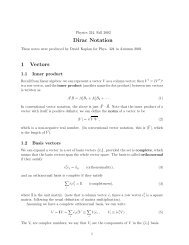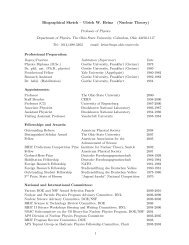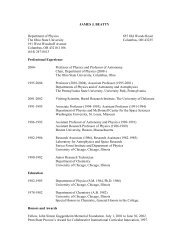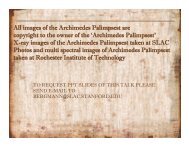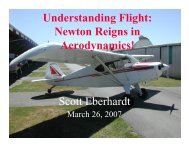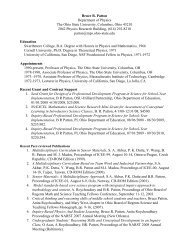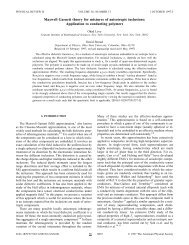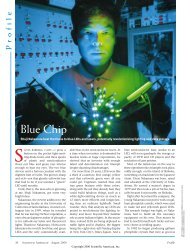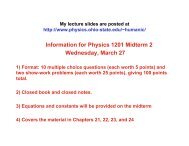Graduate Study in - Department of Physics - The Ohio State University
Graduate Study in - Department of Physics - The Ohio State University
Graduate Study in - Department of Physics - The Ohio State University
You also want an ePaper? Increase the reach of your titles
YUMPU automatically turns print PDFs into web optimized ePapers that Google loves.
Advanced Research Courses<br />
A unique feature and a great strength<br />
<strong>of</strong> our curriculum are the numerous<br />
advanced-topics courses at the 6800 or<br />
8800 level. <strong>The</strong>se are courses on topics<br />
<strong>of</strong> current <strong>in</strong>terest <strong>in</strong> physics taught by<br />
faculty work<strong>in</strong>g <strong>in</strong> those areas. Classes<br />
are usually small and provide an<br />
outstand<strong>in</strong>g opportunity to explore the<br />
frontiers <strong>of</strong> physics <strong>in</strong> a more <strong>in</strong>formal<br />
atmosphere. We typically <strong>of</strong>fer five or<br />
more <strong>of</strong> these courses every semester,<br />
except summer. Survey courses (6800<br />
level) are <strong>of</strong>fered regularly on the<br />
follow<strong>in</strong>g topics:<br />
Astrophysics<br />
Atomic and molecular physics<br />
Biophysics<br />
Condensed matter physics<br />
Elementary particle physics<br />
Nuclear physics<br />
<strong>Physics</strong> education<br />
Str<strong>in</strong>g theory<br />
Advanced topics are covered <strong>in</strong> a series <strong>of</strong><br />
courses at the 8800 level, which <strong>in</strong>clude,<br />
but are not limited to, the follow<strong>in</strong>g:<br />
Atomic and molecular physics<br />
Biophysics<br />
Condensed matter physics<br />
Cont<strong>in</strong>uum mechanics<br />
Dynamical systems<br />
Elementary particle physics<br />
Field theory<br />
Group theory<br />
Lasers<br />
Low-temperature physics<br />
Magnetic properties <strong>of</strong> matter<br />
Many-particle physics<br />
Nonl<strong>in</strong>ear optics<br />
Nuclear physics<br />
Phase transitions and critical phenomena<br />
<strong>Physics</strong> education<br />
<strong>Physics</strong> <strong>of</strong> organic and polymeric<br />
materials<br />
Spectroscopy<br />
Str<strong>in</strong>g theory<br />
Superconductivity<br />
<strong>The</strong>ory <strong>of</strong> measurement and detection<br />
You also can study a topic <strong>of</strong> your choice<br />
on an <strong>in</strong>dividual basis with a faculty<br />
member through <strong>Physics</strong> 7193.<br />
6 • physics.osu.edu<br />
<strong>The</strong> resources <strong>of</strong> the university and <strong>of</strong> the physics department are available to assist<br />
you with job placement after graduation. Recent graduates now have successful careers at<br />
colleges, universities, national research laboratories, and <strong>in</strong> <strong>in</strong>dustry.<br />
QUAlIFYING AND BECOMING A PHD CANDIDATE<br />
<strong>The</strong> first step <strong>in</strong> becom<strong>in</strong>g a PhD candidate is to qualify via the “core-course requirement.”<br />
This is accomplished by tak<strong>in</strong>g the six semesters <strong>of</strong> core courses shown earlier <strong>in</strong> the course<br />
sequence box and achiev<strong>in</strong>g at least a B+ average <strong>in</strong> these courses. Students com<strong>in</strong>g <strong>in</strong>to our<br />
program with previous graduate-level course experience may petition to waive some or all <strong>of</strong><br />
these courses.<br />
After satisfy<strong>in</strong>g the core-course requirement, research becomes the center <strong>of</strong> your PhD<br />
program. After work<strong>in</strong>g for one or two semesters with your advisor, you will prepare for the<br />
candidacy exam<strong>in</strong>ation. This exam is set by your advisor and advisory committee. It consists <strong>of</strong> a<br />
short paper on a topic related to your research project. Admission to PhD candidacy follows the<br />
satisfactory performance on the candidacy exam<strong>in</strong>ation.<br />
<strong>The</strong> PhD program concludes with a written dissertation, based upon the scientific advances<br />
you made through <strong>in</strong>dependent research, and an oral defense <strong>of</strong> your thesis. <strong>The</strong> average time<br />
for completion <strong>of</strong> the PhD program is about six years.<br />
BECOMING A BETTER PHYSICIST<br />
An important aspect <strong>of</strong> physics is <strong>in</strong>teraction with other physicists. <strong>The</strong> <strong>Department</strong> <strong>of</strong> <strong>Physics</strong><br />
at <strong>Ohio</strong> <strong>State</strong> encourages advanced students to attend national conferences. It is common for<br />
students to present three to four papers at conferences before complet<strong>in</strong>g their PhD. <strong>The</strong> annual<br />
Smith lecture br<strong>in</strong>gs <strong>in</strong>ternationally recognized physicists—typically Nobel Prize w<strong>in</strong>ners—to<br />
the department every spr<strong>in</strong>g. <strong>The</strong> weekly colloquia feature easily accessible <strong>in</strong>sight <strong>in</strong>to cutt<strong>in</strong>gedge<br />
research <strong>in</strong> all fields <strong>of</strong> physics. In addition, each research group also <strong>in</strong>vites collaborators<br />
and recognized researchers to present f<strong>in</strong>d<strong>in</strong>gs <strong>in</strong> their fields.<br />
Our students publish an average <strong>of</strong> five papers by the time they graduate, a testimonial to<br />
the quality and depth <strong>of</strong> tra<strong>in</strong><strong>in</strong>g they receive. When they graduate, our students are highly<br />
competitive <strong>in</strong> the job market, and virtually all f<strong>in</strong>d employment.<br />
You can contact members <strong>of</strong> the faculty <strong>in</strong>dividually and arrange to meet them if you come to<br />
the department for a visit. We appreciate the important role graduate students play <strong>in</strong> research<br />
and are always happy to discuss your needs and concerns.<br />
RESEARCH OPPORTUNITIES AND AFFIlIATED FACUlTY<br />
Diversity <strong>of</strong> active research areas is one <strong>of</strong> the great strengths <strong>of</strong> the <strong>Department</strong> <strong>of</strong> <strong>Physics</strong><br />
at <strong>Ohio</strong> <strong>State</strong>. Research spans the entire spectrum <strong>of</strong> matter, <strong>in</strong>clud<strong>in</strong>g high energy physics,<br />
nuclear physics, atomic and molecular physics, condensed matter physics, biophysics, and<br />
astrophysics. Research <strong>in</strong> physics education is another strong, vibrant field at <strong>Ohio</strong> <strong>State</strong>. With<br />
recent hires and new center fund<strong>in</strong>g, we are especially strong <strong>in</strong> condensed matter physics,<br />
high energy physics, nuclear physics, biophysics, astrophysics, AMO, cold atom theory, and<br />
physics education research. You will f<strong>in</strong>d details <strong>of</strong> the different research groups beg<strong>in</strong>n<strong>in</strong>g on<br />
page 8.




